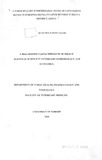| dc.description.abstract | A participatory study of the epidemiology of contagious bovine pleuropneumonia (CBPP) (loukoi) was carried out in Lapur Division of Turkana District in four grazing groups (Adakars) namely, Narakibuk, Ng'isaricho, Ikong and Eipa Adakars. The study was carried out with four specific objectives: 1) to determine the capacity of livestock keepers to diagnose CBPP; 2) to estimate the morbidity and mortality rates in cattle due to CBPP; 3) to assess the socio-economic impact of CBPP relative to other important diseases; and 4) to identify the best-bet options for improving CBPP
control.
A participatory appraisal research methodology was used in the data collection process in March and April 2002. A serological survey was incorporated to test the CBPP status of the animals. Semi-structured interviews, matrix scoring, proportional piling and trend-lines were carried out with informants who included elders, women and young menJherders. Rinderpest (lokio) , anthrax (enomokere), CBPP (loukoi), rabies (long 'okuo) and ear infection (lokit) among others were the list important or priority cattle diseases generated by informants. Lokio, enomokere, long 'okuo and Lokit were the 'controls' while loukoi was the disease of interest.
Analysis of matrix scoring of clinical signs and post-mortem lesions against diseases demonstrated good agreement between the 12 informant groups (Kendall's coefficient of concordance (W) values between 0.680 to 1.000). The livestock keepers associated lacrimation, diarrhoea and salivation with lokio by assigning more scores to these clinical signs. Madness or aggressiveness was associated with long 'okuo and lokit.
Herders associated swollen lymph node (unilateral on the head region) and sudden death with lokit and enomokere respectively. During matrix scoring exercise, livestock keepers associated loukoi with coughing, dyspnoea, yellow fluid in the chest cavity and lungs adhering to the chest cavity, which are the signs and lesions inexperienced professional will look for to make a presumptive diagnosis if the case in question is CBPP or not. However, results of the laboratory CFT, field CFT and the owner diagnosis for the last six months when compared using Kappa statistic, showed the following: There was fair to good agreement between field CFT and laboratory
CFT - Kappa value 0.61S (0.333 to 0.897 at 9S% CI), poor agreement between laboratory CFT and owner historical diagnosis based on clinical signs for the last six months - Kappa value 0.179 (-O.IIS to 0.473 at 9S% CI) and poor agreement between field CFT and owner historical diagnosis for the last six months - Kappa value 0.196 (-0.096 to 0.488 at 9S% CI).
It is important to note that the results of owner historical diagnosis of loukoi were likely to be biased for two reasons: 1) The livestock keepers expectations of assistance in drugs and vaccines provision because examined animals if found sick were treated and this could have prompted them to present animals that were not necessary sick and 2) Livestock keepers recall bias, as the results were retrospective in nature. The author's assessment of cattle presented by livestock keepers for clinical examination for CBPP status were not showing any clinical signs of CBPP. The owners' opinion of cattle thought to have suffered from loukoi from
previous six months were not suffering from loukoi during March and April 2002
(Appendix xiv) indicating a perfect/excellent agreement beyond chance (Kappa =1.000) between the veterinarian and livestock owners. In conclusion it is the writer's opinion based on narratives of clinical signs and post mortem lesions of loukoi, analysis of matrix scoring of clinical signs and postmortem lesions against diseases and believes on transmission of the same disease, that the capability of livestock keepers to diagnose loukoi is good. It is only the laboratory tests, which can redefine CBPP status of suspected cases where a 'gold standard test' is absent.
According to the perceptions of livestock keepers the annual morbidity rate due to loukoi was estimated at 12.1% (l0.59 to 13.6% at 95% CI), using proportional piling methodology with 57 herds/informants in the year 2001-2002. The annual mortality rate due to loukoi was also estimated at 8.1% (6.9 to 9.3% at 95% CI) year 2001-2002.
Livestock keepers ranked loukoi second to lobo in terms of diseases that cause both social and economic losses. Long 'okuo, enomokere and lokit were ranked third, fourth and fifth respectively. Analysis of losses versus diseases demonstrated good agreement between the 12 informant groups (Kendall's coefficient of concordance (W) values between 0.474 to 0.764) for indicators like milk, meat, fat, dowry and hides among others. However the results showed weak agreement between the 12 informant groups (W value of 0.179) for the indicator 'sale value' which was not significant according to the critical values p<0.05). The assessment of losses was
carried out using indicators which pastoralists could understand in their local
language i.e. milk, meat, blood, dowry, calves, and hides among others.
Good agreement was evident among the six informant groups concemrng the
associations of prevention and control methods of loukoi and the indicators i.e. low financial cost, effectiveness, user friendliness, group action and individual action (W Values of 0.459 to 0.861). In general informants agreed on vaccination as the best option in the prevention of loukoi by assigning most scores. 'Community-enforced quarantine' and peace were ranked second and third respectively as other important prevention methods. Modem drugs and traditional herbal remedies were ranked almost as equal methods in terms of frequency of use in the control of loukoi . Trendlines of loukoi, veterinary drugs and vaccines delivery 'levels' from 1978 to 2002 demonstrated that pastoralists perceive loukoi as an endemic disease in the study area.
The results of this study demonstrated that participatory appraisal was a useful, practical and valid research methodology, especially in a pastoral setting where there are very limited facilities, poor infrastructure and alarming levels of illiteracy. | |

